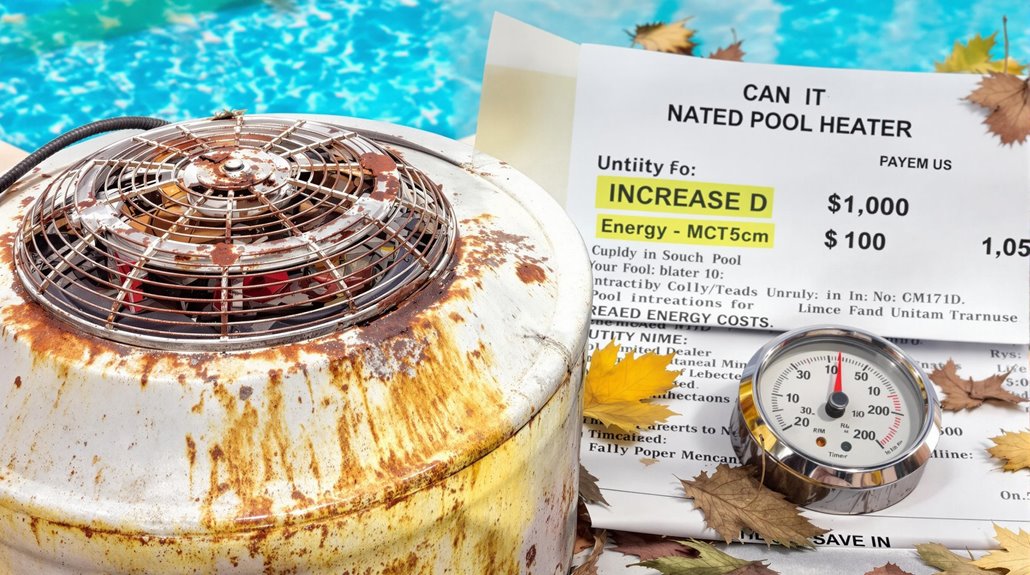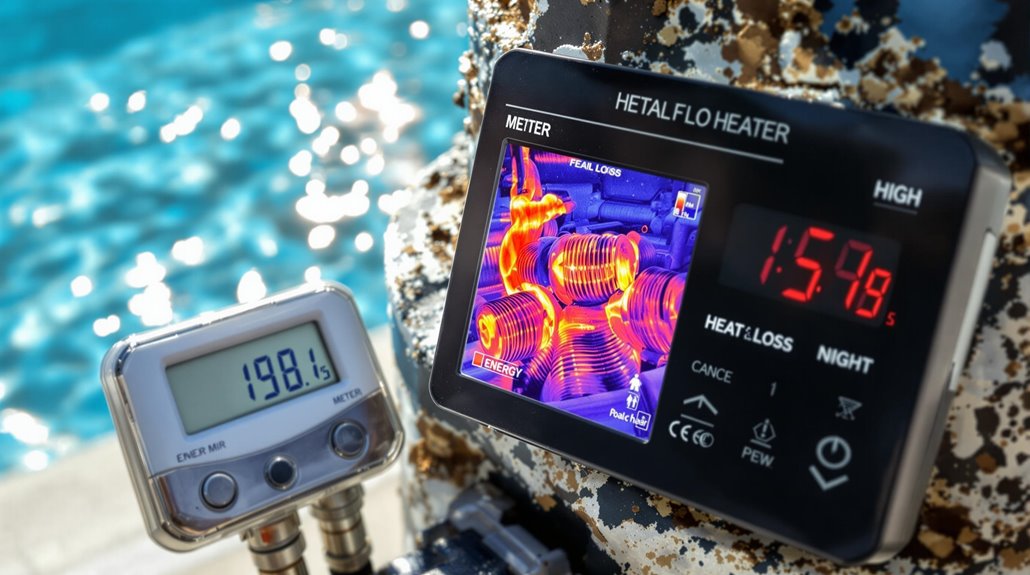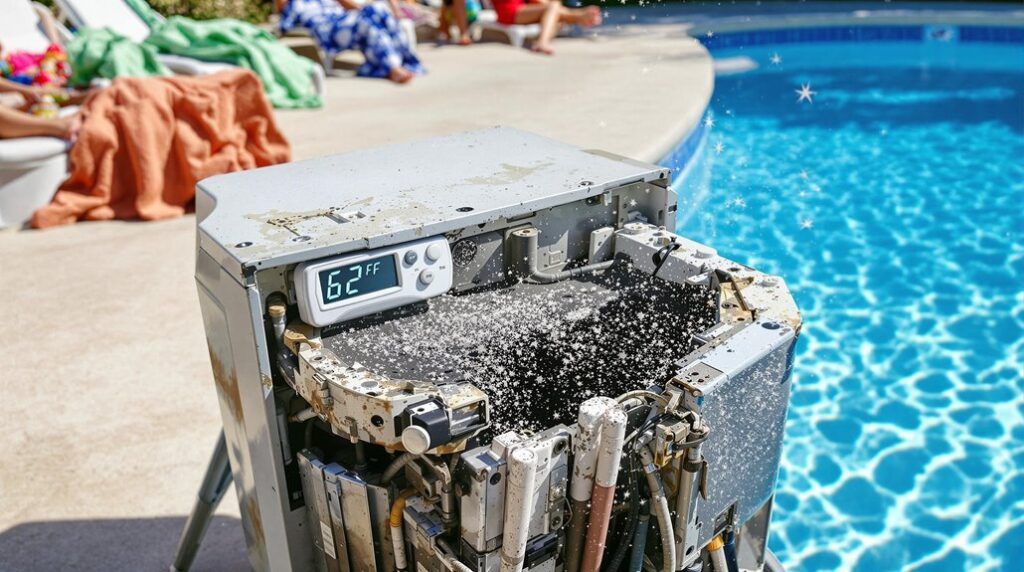Your pool heater requires consistent maintenance to prevent costly consequences you might not expect. Without regular care, you’ll face 30-50% higher energy bills, risk equipment failures costing $3,500+, and lose 10-15% efficiency yearly. Proper maintenance extends your heater’s life by 1-2 years, guarantees safe water temperatures, and prevents emergency repairs ranging from $500 to $1,000+. Understanding the full scope of maintenance benefits will help protect your investment and family’s safety.
The Hidden Costs of Neglecting Your Pool Heater

Whilst many pool owners focus on water chemistry and filtration, neglecting your pool heater can lead to extensive hidden costs that greatly impact your wallet. You’ll face increased energy bills of 30-50% as heaters run inefficiently, turning a $100 monthly expense into $150 or more. Without regular maintenance, heat pumps lose 10-15% efficiency yearly, while dirty filters force pumps to work harder, driving up electricity costs.
The real financial damage comes from preventable equipment failure. Unmaintained heat exchangers, corroded components, and clogged burners can lead to complete system failures, costing you $3,500+ for replacements. By investing in regular maintenance, you’ll extend your heater’s life by 1-2 years and avoid expensive emergency repairs ranging from $500 for descaling to $1,000+ for core replacements.
Safety First: Protecting Your Family and Investment
Beyond the financial considerations of pool heater maintenance, protecting your family’s safety should be your top priority. Regular inspections guarantee your heater maintains safe water temperatures below 120°F, preventing severe scalds that can occur from malfunctioning equipment.
You’ll need to implement multiple safety measures to protect everyone who uses your pool. Install safety gates around pool equipment, maintain proper fencing with reliable latches, and use quality pool covers when the area isn’t in use. Keep emergency response plans and CPR instructions clearly visible near the pool area. Don’t forget to train any caregivers or babysitters about proper temperature monitoring and safety protocols. Furthermore, establish a regular maintenance schedule for your heater’s thermostat calibration, making certain it operates reliably and prevents dangerous temperature fluctuations.
Peak Performance: Maximizing Energy Efficiency

Since proper maintenance directly impacts your pool heater’s efficiency, implementing key strategies can greatly reduce energy consumption and operating costs. You’ll want to focus on three main areas to maximize your heater’s performance while minimizing energy waste.
Smart pool maintenance isn’t just about longevity – it’s about maximizing efficiency while keeping those energy bills in check.
- Keep your filters clean and unclogged, as restricted water flow forces your heater to work harder, leading to increased energy use
- Install proper insulation, including solar or thermal pool covers, which can reduce heat loss by up to 50%
- Maintain consistent temperature settings between 78-82°F for gas heaters or 85-90°F for heat pumps, and avoid frequent adjustments
Regular professional inspections can identify hidden efficiency issues such as internal corrosion, while programmable thermostats help you heat the pool only at such times as needed, saving hundreds on annual operating costs.
Year-Round Care: Seasonal Maintenance Tips
To maintain peak performance throughout the year, your pool heater requires specific seasonal care and attention. When spring arrives, you’ll want to inspect key components such as the heat exchanger, thermostat, and sacrificial anode for any damage. Don’t forget to clean your filters and test the heating system after winter.
During summer, you’re in control of your heater’s efficiency by monitoring water chemistry and adjusting thermostat settings. Keep the pH and calcium levels balanced to protect metal components from corrosion. Use a soft-bristle brush to clean the heat exchanger, removing any dirt that could affect heat transfer. You’ll also need to check electrical connections and flush heater coils regularly to prevent scaling, which can reduce efficiency and increase operating costs.
Frequently Asked Questions
How Long Does a Typical Pool Heater Last Before Needing Replacement?
Pool heater lifespans by type:
- Gas heaters: 5-10 years
- Electric heaters: 15-20 years
- Solar heaters: 20-30 years
Can I Install a Pool Heater Myself to Save Money?
DIY pool heater installation is not recommended. Proper installation requires plumbing and electrical expertise. Professional installation ensures safety and maintains warranty coverage.
Which Type of Pool Heater Is Best for Cold Climates?
Gas pool heaters perform best in cold climates – they heat effectively below 50°F and operate efficiently in freezing temperatures, unlike heat pumps.
Does Running a Pool Heater Affect My Home’s Water Pressure?
Pool heaters don’t affect home water pressure. They operate on separate, dedicated circulation systems.
Can I Use My Pool Heater With a Saltwater System?
Yes. Use heaters with titanium or cupro-nickel components in saltwater pools to prevent corrosion.

